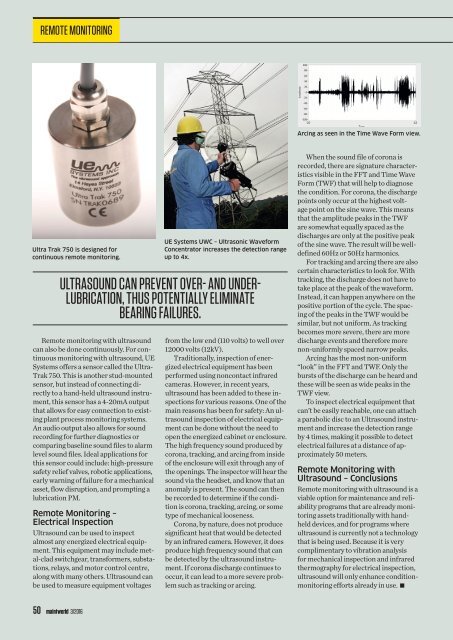Maintworld Issue3 2016
Create successful ePaper yourself
Turn your PDF publications into a flip-book with our unique Google optimized e-Paper software.
XXXXXX REMOTE MONITORING<br />
Arcing as seen in the Time Wave Form view.<br />
Ultra Trak 750 is designed for<br />
continuous remote monitoring.<br />
ULTRASOUND CAN PREVENT OVER- AND UNDER-<br />
LUBRICATION, THUS POTENTIALLY ELIMINATE<br />
BEARING FAILURES.<br />
Remote monitoring with ultrasound<br />
can also be done continuously. For continuous<br />
monitoring with ultrasound, UE<br />
Systems offers a sensor called the Ultra-<br />
Trak 750. This is another stud-mounted<br />
sensor, but instead of connecting directly<br />
to a hand-held ultrasound instrument,<br />
this sensor has a 4-20mA output<br />
that allows for easy connection to existing<br />
plant process monitoring systems.<br />
An audio output also allows for sound<br />
recording for further diagnostics or<br />
comparing baseline sound files to alarm<br />
level sound files. Ideal applications for<br />
this sensor could include: high-pressure<br />
safety relief valves, robotic applications,<br />
early warning of failure for a mechanical<br />
asset, flow disruption, and prompting a<br />
lubrication PM.<br />
Remote Monitoring –<br />
Electrical Inspection<br />
Ultrasound can be used to inspect<br />
almost any energized electrical equipment.<br />
This equipment may include metal-clad<br />
switchgear, transformers, substations,<br />
relays, and motor control centre,<br />
along with many others. Ultrasound can<br />
be used to measure equipment voltages<br />
UE Systems UWC – Ultrasonic Waveform<br />
Concentrator increases the detection range<br />
up to 4x.<br />
from the low end (110 volts) to well over<br />
12000 volts (12kV).<br />
Traditionally, inspection of energized<br />
electrical equipment has been<br />
performed using noncontact infrared<br />
cameras. However, in recent years,<br />
ultrasound has been added to these inspections<br />
for various reasons. One of the<br />
main reasons has been for safety: An ultrasound<br />
inspection of electrical equipment<br />
can be done without the need to<br />
open the energized cabinet or enclosure.<br />
The high frequency sound produced by<br />
corona, tracking, and arcing from inside<br />
of the enclosure will exit through any of<br />
the openings. The inspector will hear the<br />
sound via the headset, and know that an<br />
anomaly is present. The sound can then<br />
be recorded to determine if the condition<br />
is corona, tracking, arcing, or some<br />
type of mechanical looseness.<br />
Corona, by nature, does not produce<br />
significant heat that would be detected<br />
by an infrared camera. However, it does<br />
produce high frequency sound that can<br />
be detected by the ultrasound instrument.<br />
If corona discharge continues to<br />
occur, it can lead to a more severe problem<br />
such as tracking or arcing.<br />
When the sound file of corona is<br />
recorded, there are signature characteristics<br />
visible in the FFT and Time Wave<br />
Form (TWF) that will help to diagnose<br />
the condition. For corona, the discharge<br />
points only occur at the highest voltage<br />
point on the sine wave. This means<br />
that the amplitude peaks in the TWF<br />
are somewhat equally spaced as the<br />
discharges are only at the positive peak<br />
of the sine wave. The result will be welldefined<br />
60Hz or 50Hz harmonics.<br />
For tracking and arcing there are also<br />
certain characteristics to look for. With<br />
tracking, the discharge does not have to<br />
take place at the peak of the waveform.<br />
Instead, it can happen anywhere on the<br />
positive portion of the cycle. The spacing<br />
of the peaks in the TWF would be<br />
similar, but not uniform. As tracking<br />
becomes more severe, there are more<br />
discharge events and therefore more<br />
non-uniformly spaced narrow peaks.<br />
Arcing has the most non-uniform<br />
“look” in the FFT and TWF. Only the<br />
bursts of the discharge can be heard and<br />
these will be seen as wide peaks in the<br />
TWF view.<br />
To inspect electrical equipment that<br />
can’t be easily reachable, one can attach<br />
a parabolic disc to an Ultrasound instrument<br />
and increase the detection range<br />
by 4 times, making it possible to detect<br />
electrical failures at a distance of approximately<br />
50 meters.<br />
Remote Monitoring with<br />
Ultrasound – Conclusions<br />
Remote monitoring with ultrasound is a<br />
viable option for maintenance and reliability<br />
programs that are already monitoring<br />
assets traditionally with handheld<br />
devices, and for programs where<br />
ultrasound is currently not a technology<br />
that is being used. Because it is very<br />
complimentary to vibration analysis<br />
for mechanical inspection and infrared<br />
thermography for electrical inspection,<br />
ultrasound will only enhance conditionmonitoring<br />
efforts already in use.<br />
50 maintworld 3/<strong>2016</strong>

















